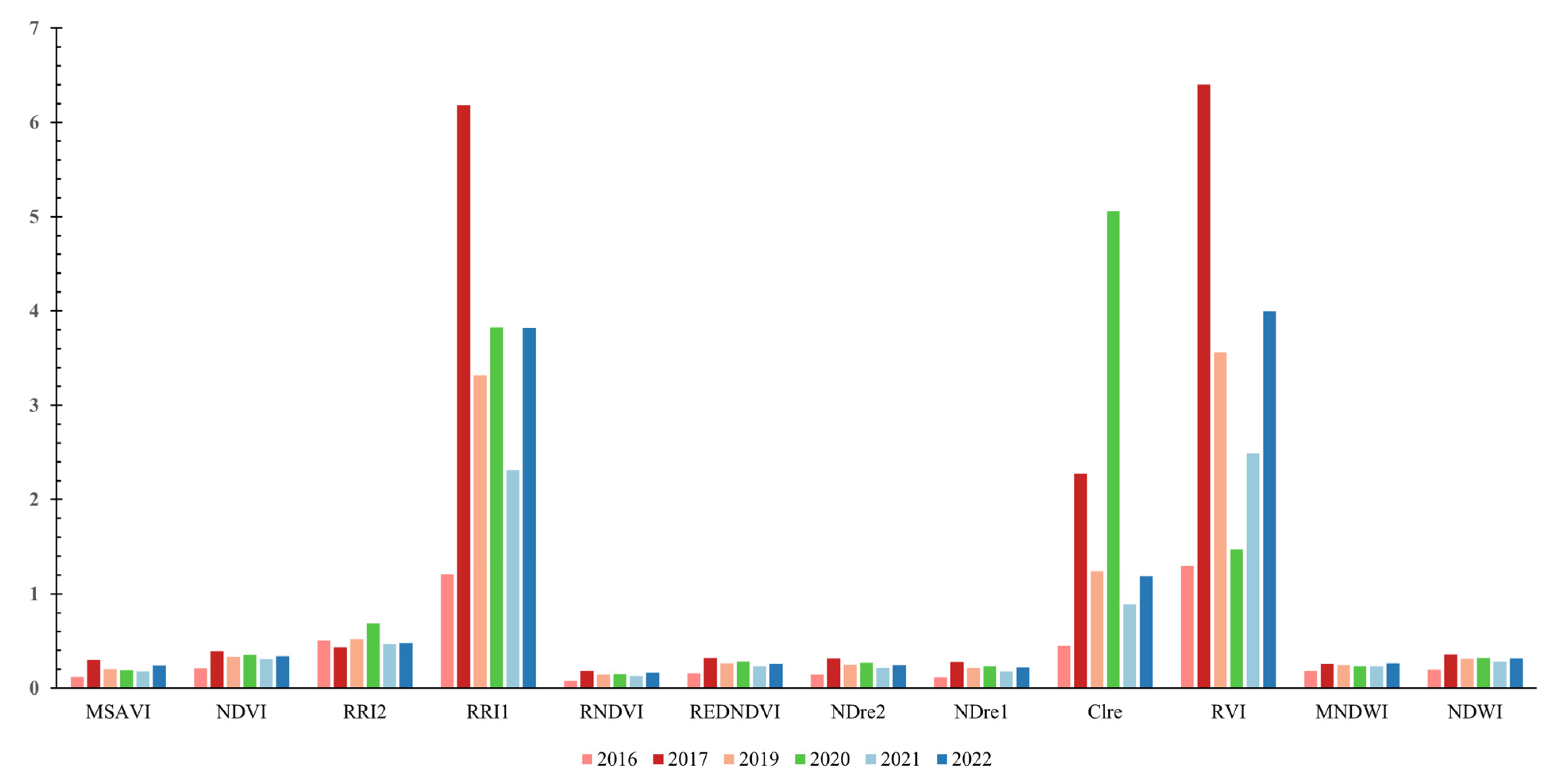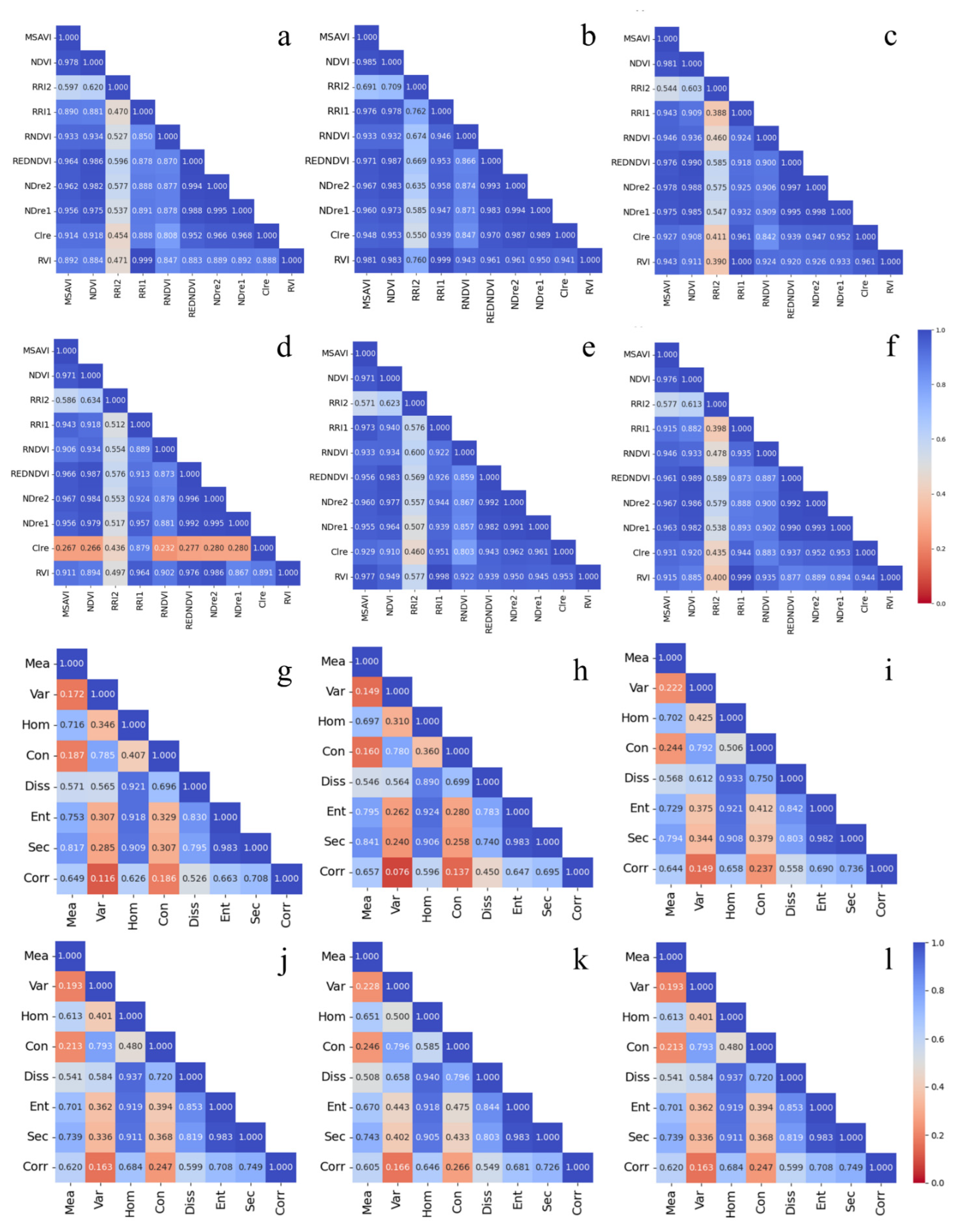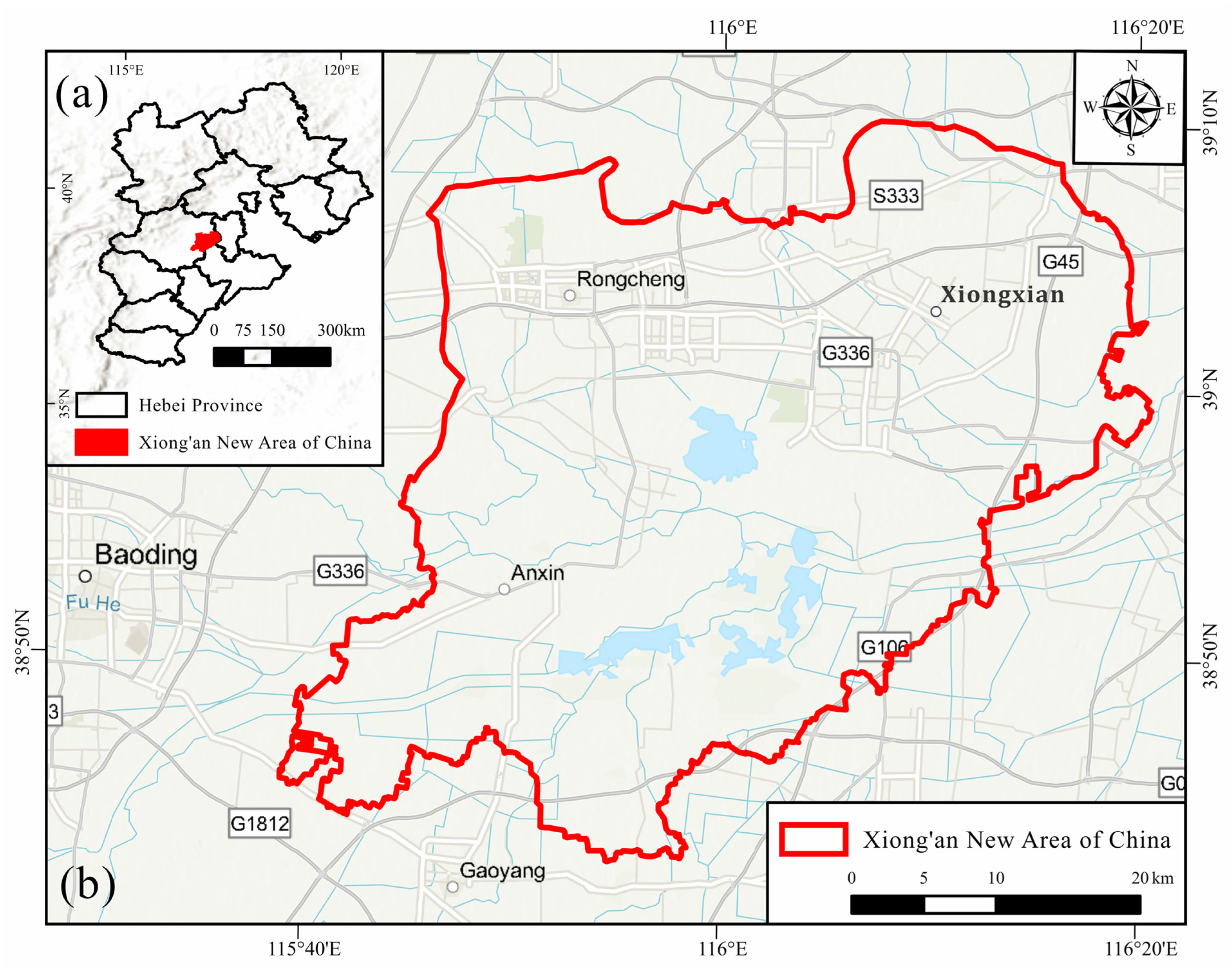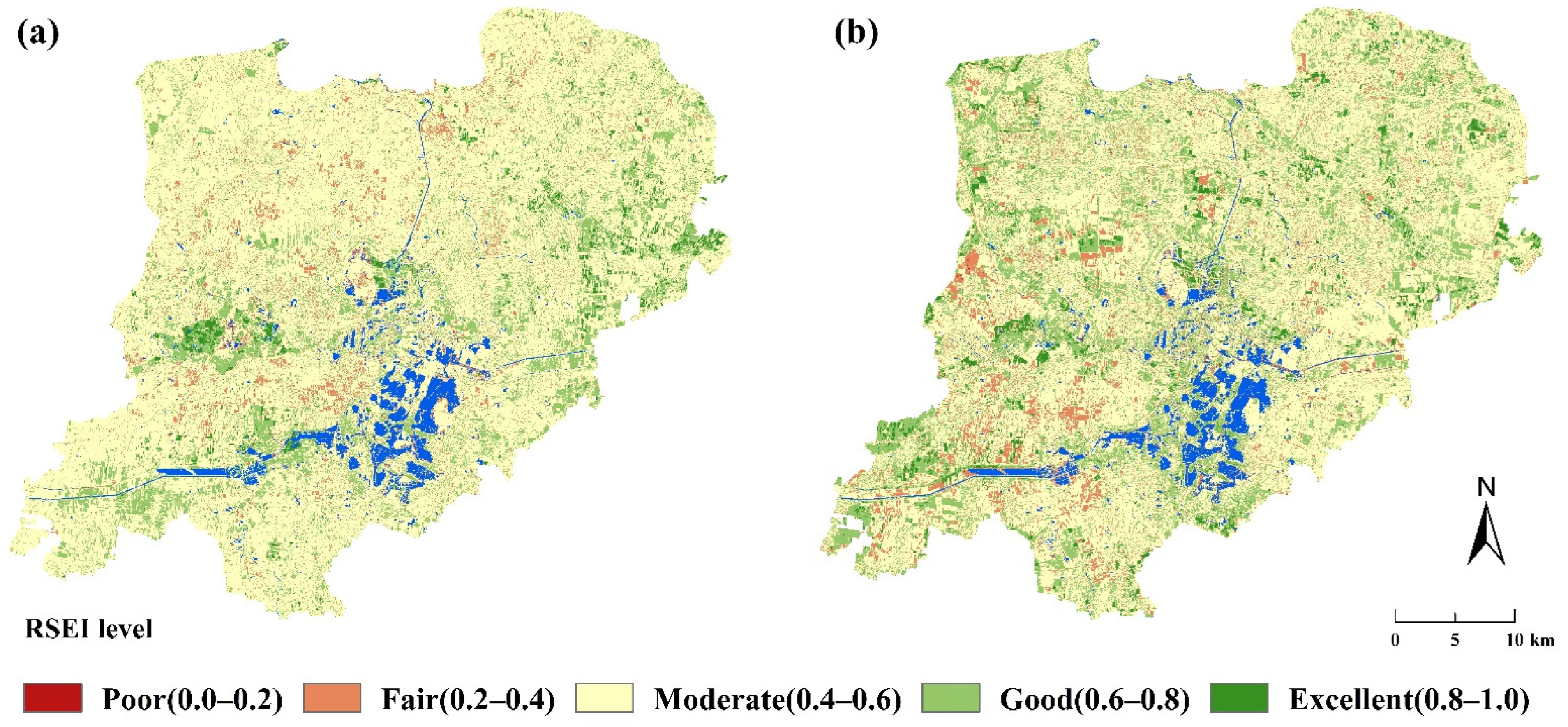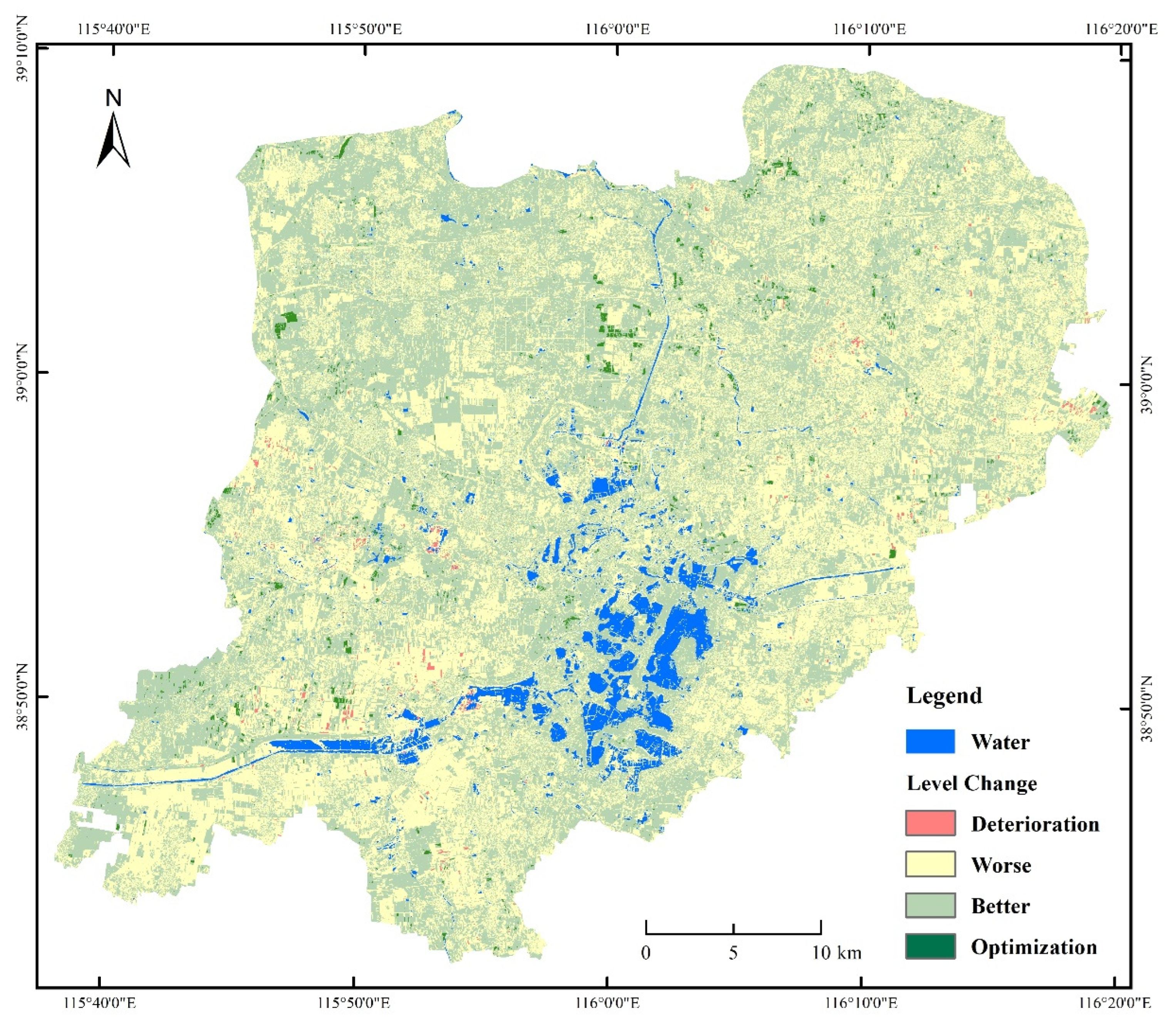1. Introduction
By integrating original spectra, spectral indices, and texture features, classification accuracy for land types can be remarkably enhanced [
1,
2]. However, this approach often leads to data redundancy. Optimum Index Factor (OIF) and Principal Component Analysis (PCA) can solve this problem. OIF is an effective method for selecting the most informative features from an image. Qi et al. demonstrated that the OIF method has stable performance and significant accuracy across different datasets [
3]. The PCA, consistent with OIF, also aims to reduce data volume. Applying PCA transformation to data can significantly improve the accuracy of data classification [
4,
5]. The object-oriented approach to land-use/cover classification considers neighboring pixels as cohesive units, analyzing them based on multiple attributes like spectrum, shape, and texture [
6,
7]. This methodology diminishes the impact of mixed pixels, leading to the more precise extraction of surface feature information and offering both accuracy and efficiency in the process [
8]. The LCLU classification method has been employed to assess the impacts of land cover changes on ecological environments, particularly in newly developed areas.
Established in April 2017, the Xiong’an New Area joins the ranks of China’s national-level development areas, following the Shenzhen Special Economic Zone (SZSEZ) and the Shanghai Pudong New Area (SHPNA). The founding of the Xiong’an New Area serves multiple purposes: to alleviate the non-capital functions of Beijing, to pioneer optimized development models for highly populated areas, to refine the spatial structure and urban layout of the Beijing–Tianjin–Hebei region, to foster innovation-driven growth engines, and to champion a sustainable ecological environment [
9,
10]. Since its inception, there has been a marked uptick in construction activity in the area [
11]. The road network has nearly doubled over a span of three years [
12]. Conversely, metrics show declines in cultivated lands, forests, and hydrophytes [
6]. In recent years, research on the ecological aspects of the Xiong’an New Area has been extensive, with predominant themes centered on ecological quality [
10,
13,
14,
15], detection of land-use changes [
11,
12,
16], projections for future land-use alterations [
17,
18], and studies of wetland [
19,
20,
21].
The development of the Xiong’an New Area has the potential to substantially transform its landscapes. Effective urban construction planning is pivotal for the efficient management of the region’s land resources. As such, it becomes imperative to continuously monitor and assess both the changes in land cover/land use (LCLU) and their ecological implications. Current research on land use in the Xiong’an New Area is limited to the year 2020 [
16], and although there is research on the ecology from 2021 [
14], the observational indices used (NDVI/NDWI) are quite simple and do not reflect the real ecological situation of the Xiong’an New Area in recent years. Moreover, most studies focus on the changes after the establishment of the Xiong’an New Area [
10,
16], whereas this study sets the timeframe before and after its establishment, better reflecting the impact of rapid urbanization on the region. In this study, we harness Sentinel-2 satellite data to evaluate the ecological impacts of landscape alterations in the Xiong’an New Area. Factoring in the various land-use types in the region, we selected four pertinent feature indices. We then developed a feature variable optimization method tailored for the land-use classification of the area spanning 2016 to 2022. The OIF was employed to choose the original image bands. In parallel, vegetation indices, red-edge features, water indices, and texture features were discerned through correlation, standard deviation, and principal component analysis. This methodology pinpointed the most apt features for land-use classification from each feature index, leading to the creation of an optimal feature set, which was then incorporated into machine learning models. This study not only harnesses feature selection for classification purposes but also delves deeper, investigating both land-use shifts and the corresponding ecological quality transformations within the Xiong’an New Area. This comprehensive approach, grounded in the application of advanced feature selection methods, sets our work apart, providing a holistic analysis that encompasses both classification and its real-world implications. This study’s results offer invaluable guidance for the region’s continued construction, development, and ecological conservation endeavors. Overall, our findings play a pivotal role in charting the future trajectory of the Xiong’an New Area.
5. Results
5.1. Land-Use Classification Results Based on Different Feature Combinations
Table 5 presents the classification results across the eight scenarios. When using only spectral features for land surface cover classification in the Xiong’an New Area, the overall accuracy is the lowest, at 94.496%. By incorporating vegetation and water body indices in Scenario 2, the overall accuracy is increased by 0.932%, while the Kappa coefficient experiences a slight rise. Building on Scenario 2, the introduction of red-edge and texture features boosts the overall accuracy and Kappa coefficient by 1.566% and 1.950%, and 0.018 and 0.023 respectively. This underscores that integrating red-edge and texture features can significantly enhance the accuracy of land-use classification in the Xiong’an New Area, with the addition of texture features providing a more noticeable boost compared with the red-edge features. Scenario 5 amalgamates all feature variables and achieves an overall accuracy of 97.382% with a Kappa coefficient of 0.970, though the enhancement is marginal. Out of all of them, Scenario 6 stands out, delivering the highest overall accuracy and Kappa coefficients at 98.673% and 0.984, respectively. Impressively, by paring down the feature variables from 31 to 15, there was an uptick in both accuracy and processing efficiency.
The details of the producer’s accuracy and user’s accuracy for each land cover class in scenarios 1–8 are shown in
Appendix E.
To assess the effectiveness of the Support Vector Machine (SVM) in land-use classification for the Xiong’an New Area, this study tested three prominent machine learning algorithms: SVM, RF (Random Forests), and NNC (Neural Net Classification), using the optimal band combinations identified post-feature selection. The comparative analysis, as detailed in
Table 5, demonstrates that SVM outperforms the other two algorithms. It achieved an impressive overall accuracy of 98.673% and a Kappa coefficient of 0.984. This was 1.412% and 0.016 higher than RF and 0.674% and 0.007 higher than NNC, respectively. In essence, our proposed SVM approach, underpinned by multifaceted feature selection, significantly enhances classification precision in the Xiong’an New Area.
To evaluate the efficacy of the SVM model for land-use classification in the Xiong’an New Area, optimized band combinations were applied to three prevalent machine learning algorithms for remote sensing imagery: Support Vector Machine (SVM), Random Forest (RF), and Neural Net Classification (NNC). These correspond to scenarios 6, 7, and 8, respectively, with the results and processing times presented in
Table 5 and
Table 6. SVM emerged as the top performer, boasting an overall accuracy of 98.673% and a Kappa coefficient of 0.984. It surpassed RF by 1.412% in accuracy and 0.016 in the Kappa coefficient and outdid NNC by 0.647% in accuracy and 0.007 in the Kappa coefficient. However, its superior performance came at the cost of efficiency, taking 128 min—making it the lengthiest. NNC struck a balance between accuracy and processing speed, ranking second in both. In contrast, while RF offered the quickest classification, it lagged in accuracy. Despite RF’s speed, the limited image dataset in this research shifted the focus to classification precision over processing efficiency. Nonetheless, in larger datasets, the efficiency of RF could be invaluable—despite a marginal drop in accuracy, it cuts processing time by a third, marking it as highly efficient. However, since accuracy was paramount in our study, SVM was selected for subsequent annual classifications.
5.2. Land-Use Classification Results Based on Feature Optimization for 2016–2022
Using the optimal spectral features, vegetation indices, red-edge features, and texture features, we applied the SVM algorithm for classification for each year. The classification accuracies spanning from 2016 to 2022 are detailed in
Table 7. The overall accuracies for these years were 92.853%, 98.470%, 96.139%, 96.694%, 94.639%, and 95.707%, respectively. Simultaneously, the Kappa coefficients were 0.917, 0.982, 0.953, 0.959, 0.936, and 0.949, respectively. Analyzing the land-use classification results across the years, 2017 boasted the highest accuracy, while 2016 registered the lowest.
The land-use transition matrix, along with the evolution of land-use patterns in the Xiong’an New Area from 2016 to 2022, is detailed in
Table 8 and visualized in
Figure 2. The data from these sources highlight that, in 2016, grassland and unused land predominantly characterized the Xiong’an New Area’s landscape. However, by 2022, farmland had emerged as the predominant land-use category, signaling a marked shift from the prior dominance of grassland and unused spaces. The most substantial land conversion was observed in the farmland, which expanded by 518.41 km
2. In contrast, water bodies registered the most minimal change, expanding by a mere 9.3 km
2. The forested region also saw an augmentation, growing by 68.11 km
2, a development attributed substantially to the “Millennium Show Forest” initiative. Conversely, there was a contraction in the extents of grassland, unused land, hydrophytes, and roadways. Of these categories, the grassland experienced the sharpest decline, closely followed by the unused land category.
Between 2016 and 2022, the built-up area expanded from 182.15 km2 to 205.12 km2, predominantly resulting from the conversion of grasslands, unused lands, and roadways. Despite this growth, some buildings were re-purposed into farmland, grasslands, and roads in line with the Xiong’an New Area’s strategic urban planning, which emphasizes a logical layout and the restructuring of infrastructure. Notably, these transformations were most prevalent in the starting area and the northern regions of Rongdong and Rongxi within Rongcheng County. By 2019, settlements in the starting zone had evolved to be denser and more ecologically harmonious. That same year marked the commencement of the Xiong’an Station high-speed railway construction in Jiugang, positioned northeast of Xiongxian County. The year 2020 witnessed the addition of numerous roads and rail links within the starting zone, laying the foundation for an integrated rail transit system linking the Xiong’an New Area both internally and to neighboring urban centers. In 2021, the Baiyangdian water body expanded eastwards and, by 2022, had further grown southwestward, making Baiyangdian a prominent feature across the entire Xiong’an landscape. The “Millennium Show Forest” project, initiated in 2017, has notably bolstered the forest cover in Xiongxian County, counteracting the decline in grassland and unused areas. In terms of developmental vigor, Rongcheng County and Xiongxian County lead the way, while Anxin County lags slightly. Nevertheless, the overarching trajectory for the Xiong’an New Area remains steadfast in its commitment to an environment epitomized by “clear skies, lush lands, and pristine waters”.
5.3. RSEI
According to Xu [
26], the RSEI values are segmented into five distinct levels, each with an interval of 0.2, to depict the spatial distribution of ecological environment quality. These levels are as follows: Level 1: Ecological Inferior (0, 0.2), Level 2: Poor (0.2, 0.4), Level 3: Moderate (0.4, 0.6), Level 4: Good (0.6, 0.8), Level 5: Excellent (0.8, 1). The geographical representation of these RSEI levels can be visualized in
Figure 3. Additionally, details such as the area, proportion, and average RSEI value for each level are provided in
Table 9.
Table 9 indicates that the mean RSEI had been almost unchanged from 2016 to 2022 with only a slight increase of 0.01. In both 2016 and 2022, the predominant RSEI levels in the Xiong’an New Area were ‘Moderate’ and ‘Good’, covering areas of 1573.28 km
2 and 1490.34 km
2, which correspond to 91.46% and 86.64% of the entire region, respectively. The distribution map of RSEI levels also reveals the expansion of excellent RSEI areas of the Xiong’an New Area in 2022 compared with 2016. In Xiongxian and Anxin Counties, most regions advanced to ‘Good’ and ‘Excellent’ levels, expanding by 142.90 km
2 in total. Conversely, areas classified as ‘Poor’ and ‘Fair’ grew by 59.23 km
2 across the three counties during this period.
Xiongxian’s overall ecological caliber has seen improvement, largely attributed to the initiation of the “Millennium Forest” initiative. Anxin County, on the other hand, witnessed mixed results, with areas both improving and degrading in ecological quality. Rongcheng County, being the nucleus of the Xiong’an New Area’s development, experienced the most profound development. However, its ecological integrity remained largely unaltered, even showing a slight uptick in certain regions. This stability can be credited to the region’s emphasis on preserving its inherent ecology while incorporating ecological greenways and city parks in its developmental plans.
Land-use maps reveal an augmentation in road networks in 2022 as compared with 2016. However, the Xiong’an New Area’s developmental approach has been holistic, ensuring the inclusion of green belts during road constructions, evident in developments like the urban park belt and the lush environs around the Xiong’an Station Hub. It is noteworthy that as the construction in the Xiong’an New Area is ongoing, some of the ecological projects, especially in Rongcheng County, await completion.
In this study, we also adopted an approach by using a 0.4 interval to categorize the RSEI into four distinct levels. These levels are: ‘Deterioration’ (−0.8 to −0.4), ‘Worse’ (−0.4 to 0), ‘Better’ (0 to 0.4), and ‘Optimization’ (0.4 to 0.8), as proposed by Cai et al. (2020). The spatial variations in these RSEI levels are visually depicted in
Figure 4.
Figure 4 and
Table 10 reveal that between 2016 and 2022, 48.57% of the areas witnessed a deterioration in ecological quality. In contrast, 51.43% exhibited improvements, with a spread of 2.86% favoring the latter. Notably, areas with marginal alterations (categorized as ‘Worse’ and ‘Better’) made up 98.62% of the total. Those undergoing significant positive (Optimization) or negative (Deterioration) shifts accounted for only 1.38%. The majority of improved regions were found in Rongcheng and Xiongxian counties, whereas most of the deteriorating areas lay within Anxin County. Land-use classification maps suggest that Rongcheng and Xiongxian counties had experienced a more intense developmental phase compared with Anxin County. As the Xiong’an New Area’s development strategy underscores the importance of ecological preservation, the evident RSEI level enhancement in Rongcheng and Xiongxian signifies the effective ecological management integrated into their development. Conversely, the predominant focus on cropping in Anxin County, combined with the impact of seasonal weather on immature crops, contributed to the observed decline in its ecological standing. On the whole, the ecological trajectory of the development of the Xiong’an New Area leans positively, mirroring its commitment to prioritizing ecology and promoting sustainable development.
5.4. The Spatiotemporal Distribution Characteristics of RSEI
To analyze the spatiotemporal characteristics of the RSEI on the interannual scale in the Xiong’an New Area, an EOF decomposition was performed on the RSEI indices calculated from remote sensing images from 2016 to 2022. The temporal mean values are removed from the original RSEI at every spatial location to ensure that both the spatial mode and temporal mode reflect the RSEI variability.
Figure 5a,c,e present the first, second, and third spatial modes obtained from the EOF decomposition.
Figure 5b,d,f depict the temporal modes of the EOFs. The variance contribution rates of the modes are 29.88%, 24.29%, and 17.94%, respectively, with a cumulative contribution rate reaching 72.11%, indicating that the first three modes can describe the majority of the RSEI variations.
The first mode of EOF (EOF1) illustrates a typical spatial distribution pattern of RSEI in the Xiong’an New Area. Generally, the west side of the region, specifically in Anxin and Rongcheng counties, exhibits positive values, whereas the Xiongxian area on the east side displays negative values in the first spatial mode (
Figure 5a). The first temporal mode (
Figure 5b) fluctuates between positive and negative values, starting from 2017. When combining the features of both the first spatial and temporal modes, it becomes evident that the RSEI has been in a continuous decline since 2017 in Anxin and Rongcheng. In contrast, the eastern side in Xiongxian has seen an upward trend in RSEI since 2017, as indicated by the negative values in the first spatial mode.
The second mode, shorter in temporal variation compared with the first, reflects the impact of transient driving forces (
Figure 5c). Its spatial mode (
Figure 5c) shows negative values predominantly on the southern side, mainly in Anxin county, while positive values are more common in Rongcheng and Xiongxian. Starting from 2017, the second temporal mode has shown a decline from a positive value to a negative value (
Figure 5d). This suggests that areas with negative values in the spatial mode have experienced increasing RSEI values, although there was a sharp decrease in 2023. For Xiongxian and Rongcheng, significant improvements in RSEI are projected for 2023, likely influenced by transient processes, including climate variations and anthropogenic factors like urban expansion and ecological restoration initiatives in the development of the Xiong’an New Area.
The third spatial mode reveals a mixed distribution of positive and negative anomalies (
Figure 5e). Although lacking distinct centers of high or low values, the positive anomalies are primarily scattered towards the eastern parts of the Xiong’an New Area, while negative anomalies are mostly found in the northwest, showing an inverse distribution pattern. The temporal mode fluctuates approximately every two years, as shown in
Figure 5f. In 2016 and 2017, the temporal mode was positive, indicating an increase in RSEI in the northwest and a decrease in the east. Conversely, in 2021 and 2023, a negative temporal mode suggests a decrease in RSEI in the northwest and an increase in the east.
6. Discussion
In our study, a variety of feature vectors were derived from the images by employing the technique of computing feature indices. To identify the most pertinent features, we utilized selection methodologies including the OIF index, correlation analysis, standard deviation assessment, and principal component analysis. The comparative analysis of outcomes, both with varying feature additions and those based on the optimized features, can be seen in
Table A1 and
Table A2, as well as in
Figure A1 and
Figure A2. The corresponding classification outcomes are detailed in
Table 5.
Single spectral feature-based scenarios yield satisfactory accuracy, making them suitable for studies with moderate classification precision needs. However, when integrating multiple feature variables, the accuracy noticeably improves. Notably, the scheme that leverages feature selection attains the highest accuracy. Concerning land cover classifications, adding texture features bolsters the accuracy for structures and forests. Water classifications remain consistently high across all schemes. Both texture and red-edge features play pivotal roles in enhancing the producer’s accuracy for hydrophytes. As for road classifications, the influence of red-edge and texture features far outweighs that of vegetation and water indices.
In the realm of land-use classification, an ever-growing body of scholars is turning to feature selection methods. Studies conducted in diverse regions like the Southern Hilly Region and Cultivated Areas have deployed these techniques, typically focusing on less developed areas predominated by vegetation and crops [
4]. Our study area contrasts with these regions, encompassing a blend of urban and rural landscapes, a well-structured transportation system, and Baiyangdian, the largest freshwater wetland in the North China Plain. This diverse array of land cover types introduces more complexities into land-use classification. For instance, Li et al. [
4] included six features but omitted texture features, a crucial aspect of land-use classification. We have advanced beyond the scope of Li et al.’s research, consciously excluding radar and terrain features due to our study area’s flat plain topography, where terrain effects are negligible. We reached this decision after finding, in line with Li et al.’s results, that the inclusion of radar features would diminish the accuracy in classifying building areas and unused land. Therefore, our approach offers a more tailored method for the specific challenges and characteristics of our study area.
Historically, land-use classification studies on the Xiong’an New Area have predominantly hinged on conventional methods, either spectral feature-centric (as demonstrated by Yu et al. [
11]) or employing object-oriented paradigms (like Jia et al. [
12]). Diverging from this trend, our approach hinges on an innovative feature selection method. This methodology amalgamates a diverse array of features—spectral, textural, water indices, and red-edge features—selecting the most pivotal ones to ensure succinctness, thus circumventing data redundancy. Furthermore, while prior research typically compartmentalized the area’s land use into 5–6 categories, our study meticulously subdivided it into eight distinct classes, enhancing granularity. Our method catapulted classification accuracy, achieving an unprecedented 98.673%, a marginal improvement even over previous work [
11].
The land-use changes observed between 2016 and 2022 in the Xiong’an New Area demonstrate a pronounced transformation in the regional landscape. Most prominently, the marked decrease in unused land and grasslands suggests that these areas have likely been repurposed for other land-use categories. Marginal reductions in the area occupied by aquatic plants and roads further underscore the dynamic nature of this region’s development. Conversely, the uptick in building, water body, and forest areas provides evidence of urban expansion, conservation efforts, or both.
However, it is the dramatic proliferation of farmland that stands out most conspicuously. Almost doubling its footprint since 2016, this surge in farmland challenges conventional expectations. Such a pronounced increase in agricultural territory within a relatively short time frame is atypical, especially in an era where urban expansion often encroaches upon arable land.
Upon scrutinizing the satellite imagery from both 2016 and 2022, distinct phenological differences in crop stages become evident. The 2016 image, captured on 30 September, depicts the region during a period when predominant crops, including rice and summer corn, had attained their maturity and were on the cusp of harvest. Conversely, the 2022 image, dated 21 July, captures a moment within the vegetative phase of the crop cycle when plants are vigorously growing and exhibiting maximal canopy coverage. This difference in growth stages leads to an optical illusion in satellite-derived land-use data, suggesting an expanded farmland expanse in the 2022 imagery. The crops’ denser foliage during their vegetative phase contributes to this perceived enlargement, compared with the more subdued appearance of crops nearing harvest in the 2016 image. Furthermore, this study solely focuses on the correlation between the vegetation index and red-edge characteristics, neglecting the potential high correlation among four key features: the vegetation index, red-edge characteristics, texture features, and water body index. Future research could benefit from an in-depth exploration of the interrelationships among these attributes.
An exploration into the ecological quality change in the Xiong’an New Area between 2017 and 2020, utilizing Landsat data [
11], shed light on the non-declining, slightly improving ecological state during this period. Such positive alterations, where areas witnessing ecological progress clearly outpaced degraded zones, paved the foundation for our comparative analysis. This study delved deeper, juxtaposing the ecological standards of the Xiong’an New Area prior to its 2016 inception with the data up to 2022. It illuminated a consistent upward trajectory, with enhanced ecological conditions. This research finding is observable in the land-use classification results. Interestingly, these revelations bolster the argument that the Xiong’an New Area’s urban planning has steadfastly been eco-centric, embracing sustainable development principles. This strategic approach has, commendably, shielded the region from the ecological deterioration often accompanying rampant urbanization.
Although RSEI is one of the most widely used comprehensive evaluation indices for ecological environment quality, Wang et al. [
35] have pointed out that this index, being entirely based on remote sensing data, has limitations in its application. For example, its calculation process cannot consider all ecological elements (especially water elements). Despite its wide application, there have been few improvements to RSEI’s limitations. Therefore, Wang and others have improved RSEI, and the results show that the improved model aligns more closely with the real ecological environment. This study will refer to Wang and others’ improved model in subsequent research to more accurately reveal the ecological environment quality of the Xiong’an New Area.
Since its establishment in 2017, the Xiong’an New Area, as a national-level new area, has undergone a rapid urbanization process. Rapid urbanization usually leads to a singular transformation in land-use types, with most land being converted to construction sites and roads, and causes many ecological and environmental problems. However, this trend is not evident in the Xiong’an New Area. In the land-use types of Xiong’an, construction land, water bodies, forest land, and arable land have all increased. Also, as indicated by the RSEI results, the ecological environment has not deteriorated. The Xiong’an New Area will serve as a new model for high-quality development in a new era. This suggests that the impact of rapid urbanization on land use and urban ecology in the future will be different from the past, leading to new understandings of urbanization.
Peering into the future, machine learning’s triumphant run in delivering top-notch classification accuracy prompts a logical progression towards deep learning techniques. These techniques, with their innate ability to autonomously discern and employ optimal features for classifications, can revolutionize accuracy levels. A compelling area of exploration would be to juxtapose the innate automatic feature discernment capabilities of deep learning against traditional machine learning’s feature selection to discern the superior technique for the Xiong’an New Area’s land-use classification.
